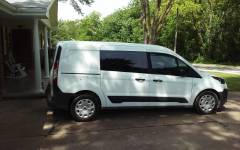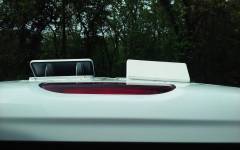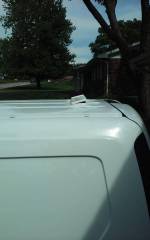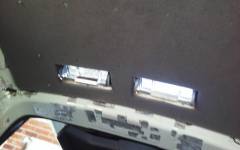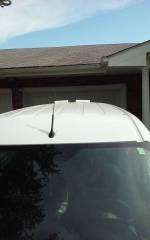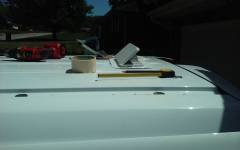
Booner
T.C. Member-
Posts
61 -
Joined
-
Last visited
-
Days Won
2
Content Type
Profiles
Forums
Gallery
Everything posted by Booner
-
Adding rear window on 2014 or newer TC?
Booner replied to 007's topic in Accessories and Modifications
I added factory glass to my 2015 TC right after I purchased the van. My dealer was a big help in they asked their glass replacement company to do it as I couldn't get glass companies to do it, (this was back in 2015 when the van was new). I think it cost me around $800 but I think it was worth it. I have much better visibility in traffic. It would be nice to have a screen in the window though. -
Take your truck into the dealer and have them load test the battery. A one year old battery shouldn't go bad, but some do; get it load tested so you know what kind of shape it's in. If it's bad, the warrantee should cover most of the cost of replacement. and it's a female dog to remove it. I'll pay someone else to do it. My battery went bad real quick, but it was four years old. These batteries are not very big, so when they start going south, it's a fast trip. It went dead twice in one week, and if I hadn't had my POD (Power on Demand) in the vehicle, it would have been a long walk. The price of the unit was just about what the cost of calling someone and getting a jump start, so I call it a worthwhile investment. On the second time it went dead, I kept on getting an error message about "Key not detected."????? I also found out that if you try and start the truck 5 or 6 times within a few minutes, the computer locks it out for 30 minutes as it resets before you can try another restart.
-
Your going to have to have something on the roof that the ARB awning can attach to. A couple of years ago I posted here how I used Unistrut to as the basis for a roof rack system- look for the post; "DIY roof rack for under $100.00." With the Unistrut attached to the channels in your roof, it would be really easy fabricate something for the ARB gusseted "L" brackets to attach to, either for permanent or casual use. You already have the holes in channels of your roof, they have plastic plugs in them. I drilled through the plastic plugs, inserted bolts through the holes in the bottom of the Unistrut and then and tightened them down with nuts and washers on the inside. I put some silicone glue around the nuts to prevent any leaks and that hasn't happened. I painted the Unistrut black first and had to slightly bend them to fit the curvature of the roof. As I said, the Unistrut is mounted permanently to my roof, but it's pretty low profile. With the accessories you can buy for the Unistrut, you'll have several options for attaching your awning. It's pretty simple to do if you have a cargo van, f you have a passenger van, you'll have to remove the roof liner.
-
Mounting a amber light ontop of the roof.
Booner replied to fordfanatictony's topic in Accessories and Modifications
I put a couple of roof vents in my van 2 1/2 years ago. I cut two holes in the uneven portion of the roof, applied silicone sealer between the roof and the base of the vents, and then screwed the vents to the roof. Wiped off the excess silicone. It has never leaked. -
I have a "scan guage II" in my TC. I purchased it years ago when I had a 1 ton van and gas was $4.00/gallon and used it to get the best mileage possible. It's programmable to monitor various real-time engine functions. I have mine programed to monitor voltage, mph, Ave. mpg, & current mpg. My point in bringing the scan guage up is it's my "engine chip. I agree that with my 2.5 liter engine and transmission, a chip isn't going to give that engine "turbo-like" performance. I don't think the engne and tranny has the additional guts that would be required. What I'm more interested in is mpg. And the scan guage does a good job of giving me real-time info. I'm very happy with the low cost of operation the TC.
-
Did Ford kill the Connect diesel and the SWB?
Booner replied to ford-diesel's topic in Transit Connect Member Custom Builds
Having worked in the power industry for 20 years, and an operator on the electric grid for 8, the thing about renewable energy that upsets me the most is that very few ever talk about it's true cost. It's such a heavily subsidised component of of the power generation industry, and we're all paying for it, either directly through taxes, or indirectly through our power bills. It's not that I'm against renewable energy; there is a place for it and it will continue to increase it's percentage share of our power generation. But what's it's true cost? Until that's known, we're all being fed a pile of B. S. -
First, since it's been so long since you asked your question, I hope you'll see my suggestion. What you want to do here is actually pretty simple. First, get some large sheets of cardboard; you'll use these to make a template for cutting out your paneling. Determine the area that you want to cover with the panals. I would suggest 1/4 inch plywood or some cheap paneling, but think thin and lite. Determine the area you want to cover with the paneling and place the cardboard over this area, and card the cardboard out to fit the area. Place the cardboard on top of the paneling and using a jig saw, or sabersaw, cut the paneling out. Put the paneling in the area you wanted covered and check for fit. Trim as needed. Now insulate the area that will behind the panel. You have a number of options for insulation, but I would use the spun glass kind that looks like cotton candy. You can stuff it into the areas between the outside and inside body panels, it light weight, will provide insulation and reduce road noise. You can either cut it out or pull it apart. Don't stuff it into spots where you have to jam it in. It doesn't insulate as well if it's overly compressed. Use some double back tape to help hold it in place. Now that the insulation is in place, put the paneling back up. You may need a friend to hold the paneling in place while you drill and drive the screws in place to hold it. Determine the leagnth of screw you need to go through the paneling and inside body of the van, but not touching the outside skin of the van. For example, the paneling is 1/4 inch and the inside metal body is 1/8 inch and the gap between the inside body panel and outside panel is a 1/2 inch. You only need screws that are long enough to go through the paneling and inside body panel and still be short enough not to contact the inside of the outer body panel. You'll want screws for use in metal, not wood, and maybe no bigger in diameter than 3/8 inch, but you want a big wide head on the screw so it won't work through the paneling. You can buy collet-type drill stops that will help insure that you don't drill too deep and go into the outside body panel. Or, use the good-old-boy method and drill through a small block of wood and use this as a drill stop. And if you feel confident, roll some tape around the drill bit as a visual stop. Tape the paneling in place, or have someone hold it and start drilling holes. Once you get a few holes drilled you can put a couple of screws in to hold everything in place while you drill the rest of the holes. At this point your insulated and have the panels in place. Now, you need to put something over the panels. You need something that has a soft, uneven texture to break up the sound waves. You have a lot of hard surfaces inside the van that relect sound. You need something that is soft and has an uneven surface to trap those sound waves. I used unbacked nylon carpet. I don't know what it's called, but purchased it online from a place that supplies automotive interior supplies, like fabric, headliners, etc. The unbacked carpet is used as a trunk liner, (I've seen people use it to cover subwoofer cabinents). It's about 3/8" thick, comes in all kinds of colors, so easy to apply, and since it's woven nylon without a backing, you can press it and stretch it into corners without it wrinkling. And it is very good for muting sound. It comes in rolls that are slightly over 4 feet wide and wast very expensive. I applied it to my panels by using contact glue, the spray on kind. I layed the carpet on a sheet of cardbord after I determined what side was going to be the back, as there was a slight difference in the Knapp on each side and I wanted that to match. I simply sprayed the glue evenly and not too heavily on the carpet, and allowed the glue to dry. I the sprayed the panels I had installed in the van. I used some scrap carboard to prevent over spray. The fumes can be pretty intense until they evaporate so open up all the doors. It may take a day or two for all the fumes to off gas, but once the glue is fully cured, there is no residual smell. Once the glue is fully dryed on both surfaces, simply press them together. The nylon has a fair amount of give so you can push it into corners or stretch it over a small gap. You'll find it's easy to work with. I used it as a headliner and a wall covering throughout the back of my van, ( I have the cargo version). On areas where there were holes in the metal, I put some duct tape over the hole and then layed the carpet over it. On the sliding doors where the Masonite panelling is attached to the sliding door, I ran a couple of layers of tape along the dge of the Masonite to help hide the hard edge. Hope this helped.
-
I don't get this buffeting with only one window open as I have a couple of roof vents which I keep open about an inch. The vents are located on the rear of the van and are low profile so they don't create any wind noise themselves unless I open them up all the way. They are also bi-directional so I can open one to force air into the van and the other opened the other way to create a draft to pull air out. When closed they are maybe an inch above the roof surface, so are sort of low profile. I'm kind of thinking about putting another pair of them right behind the driver's area where I can reach while driving....... I'm hoping to finally begin working on my build out once the temperatures cool down and am working on an idea where I'll have one fan that will pull air in one vent while another fan will push air out to camping. Oh, the vents have screens to keep the bugs out. And if you remember to close them when you wash the van, they won't leak! I also have a scan guage on my van (left over from my previous full sized van), which gives me real time info on fuel use, amoung other things. At idle, with a/c off and in park, the van burns about a quarter gallon of fuel an hour. Put the van in gear and the drag from the tranny being engaged increases the fuel us to 1/3 gallon per hour. Turn on the a/c at idle, tranny in gear, and the fuel use goes up slightly, from .33 gph to .38 maybe. Driving down the interstate at 70 mph and I'll average 28 mph, put the a/c on and I'll get 26, at least initially.
-
2018 TC Van LWB XLT First Impressions
Booner replied to davidparker's topic in Buying, Leasing, Ordering & Owner Impressions
I think I had my van for a month when I decided to have the glass installed in both sliding doors. The cost was around $800.00 but my insurance deductible is $1000 so I figured I saved $200 or more in avoiding an accident. It was a pita to get a glass company to do it. I finally went back to the dealership and they made their glass company do it. While it was pricey, I have no regrets in doing it. Having the ability to see out of the sides of my vehicle has saved me from an accident on several occasions. -
I got my WeatherTech off of Amazon.
-
Exhaust manifold removal to fit block heater?
Booner replied to Dave Spicer's topic in Accessories and Modifications
On the farm (Michigan), we put a heat lamp under the tractor up against the oil pan. That and a little ether always got them started. Other than the ease of starting, a block heater is nice as you don't have to wait for the car to warm up before the heat is available. You're electric bill will increase a little. The block heaters I've seen are around 1,000 watts or so. -
Doing a lot of Custom Stuff This Weekend
Booner replied to DapperVan's topic in Accessories and Modifications
I have a SCAN GAUGE II on my 2015 lwb 250 eng. and if you're concerned about mileage, I would suggest getting one. They're programmable to monitor different engine functions and I have mine set on voltage, gallons per hour, Ave. mileage, and current mileage. I live in central Missouri along the MO river so we have rolling hills but I drive on I-70 a lot where the speed limit is 70 mph. I do not have cruise control and that probably helps a little bit more as i tend to ease off the gas slightly going up a hill ( from 70 down to 65 mph) and once I crest the hill I slightly push on the gas to get it up to a little over 70. Driving in this manner on the interstate, I don't have much of a problem making 28 mpg. Driving on some of the 2 lanes roads I can get 30-32 mpg but then my speeds are between 55-65. The biggest help in getting good highway mileage is coasting. Coming off the freeway, coming to a light, etc. coast; If you have to use the break you didn't start coasting soon enough. Also at idle I found that my truck burns about 1/2 gallon/hour. Putting the trans in neutral drops that down to a little less than a 1/4 gallon/hour. -
0I wanted a roof rack to carry the occasional 2x4 or plywood, etc. but didn't want to spend the money required by the after market suppliers. While in my local big box hardware store I came across the aisle that contained the electrical conduit supplies. They had an item they called "UniStrut" it's made out of mild steel and looks like a "u" with rolled over lips at the top of the u. They had another item called "top grip nut" that slides in the unistrut channel then turns 90 degrees to lock into the channel. The wheels began turning in my mind. The unistrut fits into the channel in the roof of my 2015 lwb cargo van and is bolted to the roof by 3/8" bolts through the existing plastic plugs in the roof. The "top grip nuts" allow me to fasten a plate to the unistrut that allows me to add cross bars which can be adjusted depending on what I'm hauling I purchased 2, 10 foot unistuts and cut them at 6 foot for the roof rail leaving me 2, 4 foot lengths for the cross pieces 2 bags of top grip nuts (5 nuts per bag). 4-4 hole steel blocks The cost of all this was $50.00 I then purchased 1/2 inch nuts, bolts, and washers for a total of about $30.00 Time to put this all together about 5 hours I plan on buying one more piece of United and cutting it in half along with more bits and pieces to make 2, 5 foot cross bars The pictures should show you how it all went together. When I'm not carrying anything, it all comes off except for the unistrut that acts as the roof rails
-
12 volt run from battery to rear floor
Booner replied to buckethead's topic in Accessories and Modifications
I don't think a 10 gauge wire is not big enough to handle the amperage. I'm thinking a 6 gauge at a minimum. 4 gauge is probably better. You may want to visit www.battery1234 to get an idea how an automotive engineer did what your trying to do -
You can configure your alternator to charge your car battery and house battery at the same time, I wrote a long post on how to do it somewhere on this forum about a year ago. Or go to "Battery1234" for instruction on how to do it. I've also purchased a POD (power on demand) to jump start my vehicle in case of a dead battery. I haven't had to use it on my car but I have on a car at the local Wal-Mart and it started right up. I wouldn't travel without it
-
Also check what mode you have for the vents. I notice if I have the cash vents and football vents selected, it doesnt cool as well as when just the dash vents are selected. Check you owners manual for this.
-
On things like connecting speakers I like to solder the connections so they stay right. I can't stand a loose speaker connection and the price of a soldering iron shouldn't be much different than buying a wireing harness. Check out u tube for instructions in how to do it. I'm going to replace the factory speakers with some infinity's in a few days so I can report back after I've done it with my observations. I've got some dynamat-like material I could use on the door too. I've got a hearing problem and tend to listen to my music LOUD!!! So would like something to reduce the sound from escaping the vehicle.
-
MPG while towing a motorcycle?
Booner replied to omniphil's topic in Cargo, Hauling, Towing & Upfit Packages
I towed a small uhaul trailer across Kansas at 75 mph and got milave in the high 'teens/low 20's I also towed a small flatbed trailer empty and got milage in the low teens because the tailgate/loading ramp stuck up in the air like a huge sail -
From the album: Mini camper modifications
Another side shot showing how unobtrusive the vents are. If anyone asks you about them, just tell them that their an airfoil -
Mini camper modifications
Booner added images to a gallery album in Ford Transit Forum Member Albums
-
Thank you. Yes I retired at the end of this past March, moved to Missouri and looking for a house here--sold my place in Colorado which should more than pay for a new place here My family is from Missouri. I like the people and the pace of life, and reasonable living cost, the biggest negative for me is the humidity. June-July-August can be kind of rough
-
I've just begun modifing my t/c cargo into a mini camper and in doing so have found humorous holes in the undercarrage that would allow water from under the van into the interior Has it recently rained a lot or have you gone through some standing water? My van is a 2015 and I see yours is an older model so what I'm saying may not apply
-
From the album: Mini camper modifications
Vents full open with one open to the front and the other open to the rear -
From the album: Mini camper modifications
Another side view at minimal opening


